FAQs
What is Jason and what does it do?
Jason is a remote-controlled deep-diving vessel that gives shipboard scientists immediate, real-time access to the sea floor. Instead of making short, expensive dives in a submarine, scientists can stay on deck and guide Jason as deep as 6,500 meters (4 miles) to explore for days on end.
Jason is a type of remotely operated vehicle (ROV), a free-swimming vessel connected by a long fiberoptic tether to its research ship. The 10-km (6 mile) tether delivers power and instructions to Jason and fetches data from it.
Pilots and scientists back on the research ship sit in a darkened control room, monitoring instrument readouts and video screens. Using their direct cable connection, they can maneuver the vehicle in real time, direct Jason to take samples of rocks, water and sea life, and do simple construction work, like installing new instruments on the sea floor.
What is Medea?
Medea, Jason's partner vehicle, is a sort of shock absorber. It hangs from the ship near the end of the tether, where it absorbs any tension on the line from the ship moving at the sea surface. Jason is free to roam away from Medea on the remaining 55 meters (180 feet) of tether.
The tether between Medea and Jason is a .84 in. diameter, neutrally buoyant fiberoptic cable. Between Medea and the ship is a UNOLS-standard .681 in. electro-optic steel-armored cable.
Medea also carries lights that can help provide illumination for Jason's cameras and additional cameras to provide a down-look view of the vehicle.
How does Jason move around?
Jason drops to the sea floor at a rate of about 30 meters (100 feet) per minute. Six electric thrusters propel it forward, backward, sideways, up or down at a top speed of 2.8 kph (1.5 knots). When sampling, the top speed drops to 0.37 kph (0.2 knots).
Medea doesn't move around on its own, but the ship can tow it slowly through the water to keep up with Jason.
What does Jason sample?
The many instruments on Jason sample everything from basic water conditions to chunks of the sea bottom. The toolkit includes six color videocameras, one still camera, an imaging sonar, a multibeam sonar for mapping the sea floor, two robotic manipulator arms and two kinds of water samplers.
One of the water samplers collects up to 500 mL (about one U.S. pint) of sea water at a time. It's built to withstand the hot, caustic waters of hydrothermal vents. The other sampler holds less water (about 140 mL or almost 2/3 of a cup), but it maintains high pressure on the water and any dissolved gases as the sample comes back to the surface.
The manipulator arms - combined with the video cameras - let scientists reach out to the sea floor, grasp samples, and maneuver instruments into vent openings or other tight spaces.
Jason can collect samples weighing up to 130 kg (315 pounds). When scientists want to collect more than this, they have Jason place samples into a "deep-sea elevator." This is, essentially, a hammock slung in a steel frame and attached to some flotation. Elevators can be quickly assembled on deck as needed, then dropped down to Jason with weights.
What have we learned using Jason?
Jason has been used for the past 10 years to conduct research at hydrothermal vents in the Pacific, Atlantic and Indian Oceans. It has been involved in scientific research as far north as the Aleutian Trench and the Gulf of Alaska, as far west as the Lau Basin near Fiji, and as far south as nearly 40°S on the East Pacific Rise.
Jason has had another successful career in underwater archeology, capitalizing on its reputation for close-up photography, pinpoint accuracy and delicate handling. In 1989 Jason explored its first of many shipwrecks, a 1,600-year-old Roman trader dubbed Isis by its discoverers.
Working at 750 meters (nearly a half-mile) depth, Jason brought up fragile clay amphoras used for shipping wine as well as kitchen implements, an oil lamp and unique samples of sea life. Before Jason, sites like this were far out of the reach of archeologists, who were confined to scuba-diving depths (less than 100 meters or 330 feet).
The Isis shipwreck also introduced Jason as a tool for educating the public about ocean science and exploration. Images and reports from the expedition were broadcast back to classrooms as part of the JASON Project, which continues to this day.
How many people does it take to run Jason?
At minimum, Jason's shipboard crew consists of a pilot, a navigator and an engineer, plus three scientists for recording data, watching the video feed and deciding where to go and what to do.
Jason can work 24 hours per day, but crew teams rotate through four-hour shifts (two shifts per team per day). So keeping Jason going on a long mission means having three six-person teams, or 18 people onboard.
What platforms are required?
Any support ship with a traction winch, cable, and sufficient deck space for Jason and its portable control room is suitable. Many ships in the UNOLS fleet have used Jason, including the mid-sized R/V Oceanus and ocean-class Atlantis, Thompson, Revelle and Melville.
Ships with dynamic positioning capability are optimal for using Jason because they can stay fixed in one position during a dive. Basic GPS positioning is adequate for some ROV missions.
Advantages
With a depth rating of 6,500 meters (4 miles) Jason can reach more than 99% of the world's sea floor - more than any other U.S. academic research vessel.
The Jason system, including vehicles, equipment and control room, fits into standard cargo containers and can be transported by ship to any part of the world and onto any suitable vessel. This flexibility has allowed access to many remote field sites in the Pacific, Atlantic and Indian Oceans.
Jason can remain submerged for many days at a time, allowing continuous imaging, observation and sampling.
Limitations
The views that scientists and pilots get of the seafloor from an ROV system are two-dimensional, so they can be difficult to interpret. The high-resolution mapping and imaging of Jason helps with this.
Maneuvering Jason around on the seafloor is slower than with a submarine like Alvin. Each time Jason moves more than about 100 meters (330 feet), the ship and Medea have to follow. This maneuvering can be challenging in rough weather or strong currents.
Sources
Chris German, Senior Scientist, WHOI.
Matt Heintz, Jason/Medea Manager, WHOI
Dan Fornari, Senior Scientist, WHOI.
Bowen, M. F. Jason's Med adventure. Oceanus 33(1):61-69. (1990)
Shepherd, K. Remotely operated vehicles (ROVs). p. 2408-2413 in J. H. Steele, K. K. Turekian and S. A. Thorpe (eds.), Encyclopedia of Ocean Science, Academic Press, San Diego, CA. (2001)
Yoerger, D. R. Robotic undersea technology. Oceanus 34(1):32-37. (1991)
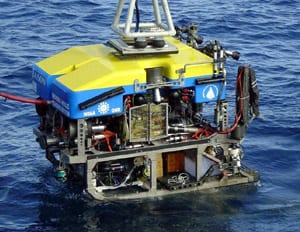
A traction winch lowers Jason into the water during sea trials in 2002. The red tether at left will remain attached during the entire dive, supplying power and relaying data between Jason and the ship. (photo courtesy Dan Fornari, Woods Hole Oceanographic Institution)
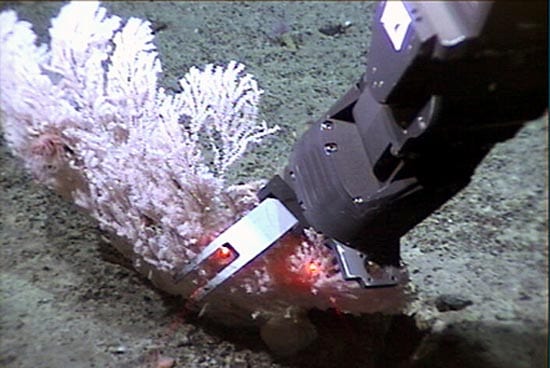
Jason's robotic arm collects a coral at 2.7 km (1.7 miles) depth during a 2004 dive to the Gulf of Alaska. The picture is one of many thousand Jason-in-action shots available for viewing via the Virtual Control Van. (photo by Woods Hole Oceanographic Institution)
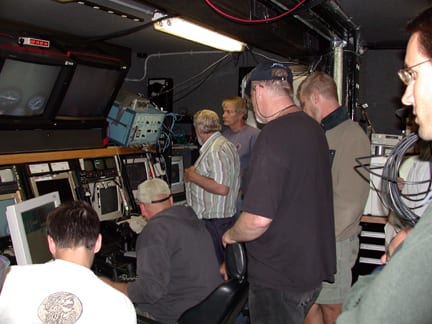
A team of six pilots, engineers and scientists controls Jason from inside the actual control van, a boxcar-sized cargo container crammed full of instrument readouts and video screens. (photo courtesy Dan Fornari, Woods Hole Oceanographic Institution)
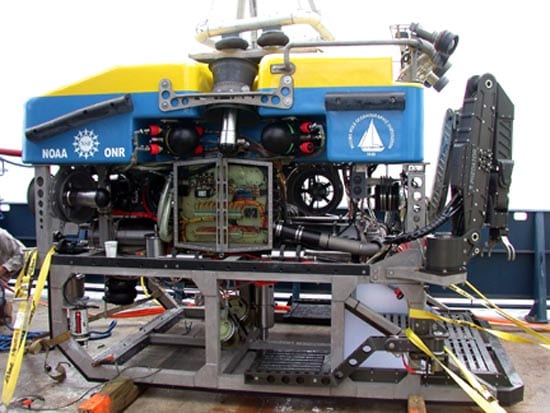
Jason on deck, side panels removed, during sea trials in 2002. At right are one of the two robotic arms and Jason's complement of lights and video cameras. The red fiberoptic tether attaches at left. (photo courtesy Dan Fornari, Woods Hole Oceanographic Institution)
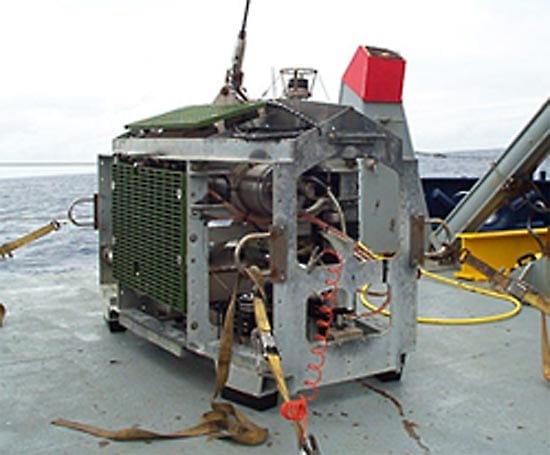
Medea, Jason's partner vehicle. Medea hangs from the research ship, attached by a steel cable (top) with the fiberoptic data tether encased inside. As the ship rolls in surface waves, the cable pulls on Medea but leaves Jason free to explore. (photo by Woods Hole Oceanographic Institution)
Jason Virtual Control Van
Watch an entire Jason dive or browse highlights from the Lau Basin, Gulf of Alaska, Hawaii, the East Pacific Rise and elsewhere.
The History of the Jason ROV
From Woods Hole Currents magazine
Archeology in Deep Water
Read more about robotic vehicles and archeology in the Mediterranean and Atlantic.
Action, Camera...Lights
A portable high-power light source promises even better sea floor photography from Jason. From Oceanus magazine.
Putting H2O in the Ocean
In 2000, Jason installed and powered up H2O, a sea floor observatory 3 miles deep off Hawaii. From Oceanus magazine.
